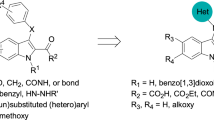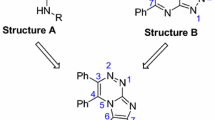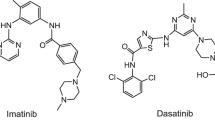Abstract
This study deals with the synthesis of novel 2-(2,3-dioxo-2,3-dihydro-1H-indol-1-yl)-N-phenylacetamide derivatives (6a–j) from isatin (3) and 5,7-dibromoisatin (4). All newly synthesized compounds were characterized using IR, 1H NMR, MS, and elemental analysis followed by evaluation of their cytotoxic activity by XTT assay on breast cancer cell line MCF-7 and non-cancer African green monkey cell line VERO. Correlation study for QSAR and in vitro assay was performed. The outcomes indicated that electron withdrawing substitutions at para position of phenyl ring and 5, 7 positions of isatin ring and increasing lipophilicity of the compound increased the cytotoxic activity. The 2-(5,7-dibromo-2,3-dioxo-2,3-dihydro-1H-indol-1-yl)-N-(4-nitrophenyl)acetamide (6b) was found to be the most active compound in the series and demonstrated higher selectivity toward MCF-7 cell line. The IC50 values were 1.96 and 1.90 μM for test compound (6b) and vinblastin (reference drug), respectively. This indicates compound (6b) may possess equipotent cytotoxic activity to vinblastine. The compound (6b) is particularly promising, since it could kill cancer cells 19–20 times more effectively than the non-cancer cells. This property of (6b) may enable us to effectively control tumors with low side effects. Hence, we propose that 2-(5,7-dibromo-2,3-dioxo-2,3-dihydro-1H- indol-1-yl)-N-(4-nitrophenyl)acetamide may be used as lead for further development.





Similar content being viewed by others

References
Abadi AH, Abou-Seri SM, Abdel-Rahman DE, Klein C, Lozach O, Meijer L (2006) Synthesis of 3-substituted-2-oxoindole analogues and their evaluation as kinase inhibitors, anticancer and antiangiogenic agents. Eur J Med Chem 41:296–305
Andreani A, Granaiola M, Leoni A, Locatelli A, Morigi R, Rambaldi M, Garaliene V, Welsh W, Arora S, Farruggia G (2005) Antitumor Activity of New Substituted 3-(5-Imidazo [2,1-b] thiazolylmethylene)-2-indolinones and study of their effect on the cell cycle1. J Med Chem 48:5604–5607
Bacher G, Nickel B, Emig P, Vanhoefer U, Seeber S, Shandra A, Klenner T, Beckers T (2001) D-24851, a novel synthetic microtubule inhibitor, exerts curative antitumoral activity in vivo, shows efficacy toward multidrug-resistant tumor cells, and lacks neurotoxicity. Cancer Res 61:392–399
Bramson HN, Corona J, Davis ST, Dickerson SH, Edelstein M, Frye SV, Gampe RT Jr, Harris PA, Hassell A, Holmes WD (2001) Oxindole-based inhibitors of cyclin-dependent kinase 2 (CDK2): design, synthesis, enzymatic activities, and X-ray crystallographic analysis. J Med Chem 44:4339–4358
Cane A, Tournaire MC, Barritault D, Crumeyrolle-Arias M (2000) The endogenous oxindoles 5-hydroxyoxindole and isatin are antiproliferative and proapoptotic. Biochem Biophys Res Commun 276:379–384
Chen Z, Merta PJ, Lin NH, Tahir SK, Kovar P, Sham HL, Zhang H (2005) A-432411, a novel indolinone compound that disrupts spindle pole formation and inhibits human cancer cell growth. Mol Cancer Ther 4:562–568
Farag AM, Mayhoub AS, Barakat SE, Bayomi AH (2008) Regioselective synthesis and antitumor screening of some novel N-phenylpyrazole derivatives. Bioorganic Med Chem 16:881–889
González A, Quirante J, Nieto J, Almeida MR, Saraiva MJ, Planas A, Arsequell G, Valencia G (2009) Isatin derivatives, a novel class of transthyretin fibrillogenesis inhibitors. Bioorganic Med Chem Lett 19:5270–5273
Hansch C, Leo A (1995) Exploring QSAR: fundamentals and applications in chemistry and biology. American Chemical Society, Washington, DC
Hung CY, Hsu MH, Huang LJ, Hwang CS, Lee O, Wu CY, Chen CH, Kuo SC (2008) Synthesis of 1-substituted 3-pyridinylmethylidenylindolin-2-ones and 1-substituted 3-quinolinylmethylidenylindolin-2-ones as the enhancers of ATRA-induced differentiation in HL-60 cells. Bioorganic Med Chem 16:4222–4232
Lindwall HG, Bandes J, Weinberg I (1931) Preparation of certain brominated cinchophens. J Am Chem Soc 53:317–319
Liu Y, Lashuel HA, Choi S, Xing X, Case A, Ni J, Yeh LA, Cuny GD, Stein RL, Lansbury PT (2003) Discovery of inhibitors that elucidate the role of UCH- L1 activity in the H1299 lung cancer cell line. Chem Biol 10:837–846
Marcsek ZL, Kocsis Z, Szende B, Tompa A (2007) Effect of formaldehyde and resveratrol on the viability of Vero, HepG2 and MCF-7 cells. Cell Biol Int 31:1214–1219
Marvel CS, Hiers GS (1941) Organic Synth 1:327
Matesic L, Locke JM, Bremner JB, Pyne SG, Skropeta D, Ranson M, Vine KL (2008) N-Phenethyl and N-naphthylmethyl isatins and analogues as in vitro cytotoxic agents. Bioorganic Med Chem 16:3118–3124
Nguyen JT, Wells JA (2003) Direct activation of the apoptosis machinery as a mechanism to target cancer cells. Proc Natl Acad Sci 100:7533–7538
Pandeya SN, Sriram D, Nath G, DeClercq E (1999) Synthesis, antibacterial, antifungal and anti-HIV activities of Schiff and Mannich bases derived from isatin derivatives and N-[4-(4-chlorophenyl) thiazol-2-yl] thiosemicarbazide. Eur J Pharm Sci 9:25–31
Pandeya SN, Smitha S, Jyoti M, Sridhar SK (2005) Biological activities of isatin and its derivatives. Acta Pharm 55:27
Sharma S, Sahu K, Jain P, Mourya VK, Agrawal RK (2008) QSAR study of 1,3–dioxo-4-methyl-2,3-dihydro-1h-pyrrolo [3,4-c] quinolines as caspase-3 inhibitors. Med Chem Res 17:399–411
Sirisoma N, Pervin A, Drewe J, Tseng B, Cai SX (2009) Discovery of substituted N -(2-oxoindolin-3-ylidene) benzohydrazides as new apoptosis inducers using a cell-and caspase-based HTS assay. Bioorganic Med Chem Lett 19:2710–2713
Skehan P, Storeng R, Scudiero D, Monks A, McMahon J, Vistica D, Warren JT, Bokesch H, Kenney S, Boyd MR (1990) New colorimetric cytotoxicity assay for anticancer-drug screening. JNCI J Natl Cancer Inst 82:1107
Solomon VR, Hu C, Lee H (2009) Hybrid pharmacophore design and synthesis of isatin–benzothiazole analogs for their anti-breast cancer activity. Bioorganic Med Chem 17:7585–7592
Torres JC, Pinto AC, Garden SJ (2004) Application of a catalytic palladium biaryl synthesis reaction, via C–H functionalization, to the total synthesis of Amaryllidaceae alkaloids. Tetrahedron 60:9889–9900
Uddin MK, Reignier SG, Coulter T, Montalbetti C, Grånäs C, Butcher S, Krog-Jensen C, Felding J (2007) Syntheses and antiproliferative evaluation of oxyphenisatin derivatives. Bioorganic Med Chem Lett 17:2854–2857
Vine KL, Locke JM, Ranson M, Pyne SG, Bremner JB (2007a) An Investigation into the cytotoxicity and mode of action of some novel N-alkyl-substituted isatins. J Med Chem 50:5109–5117
Vine KL, Locke JM, Ranson M, Pyne SG, Bremner JB (2007b) In vitro cytotoxicity evaluation of some substituted isatin derivatives. Bioorganic Med Chem 15:931–938
Acknowledgments
The authors are grateful to Cadila Pharmaceutical Limited and Zydus Research Center, Ahmedabad, India for providing assistance for 1H NMR, mass spectral, and elemental analyses, and Ganpat University, Mehsana, India for providing financial support.
Author information
Authors and Affiliations
Corresponding author
Rights and permissions
About this article
Cite this article
Modi, N.R., Shah, R.J., Patel, M.J. et al. Design, synthesis, and QSAR study of novel 2-(2,3-dioxo-2,3-dihydro-1H-indol-1-yl)-N-phenylacetamide derivatives as cytotoxic agents. Med Chem Res 20, 615–625 (2011). https://doi.org/10.1007/s00044-010-9361-y
Received:
Accepted:
Published:
Issue Date:
DOI: https://doi.org/10.1007/s00044-010-9361-y



